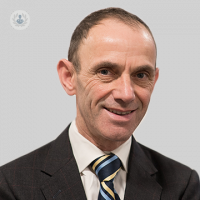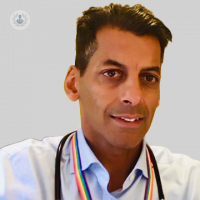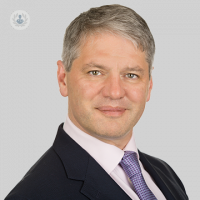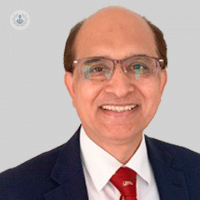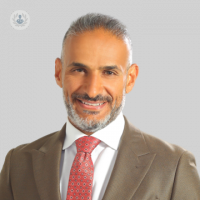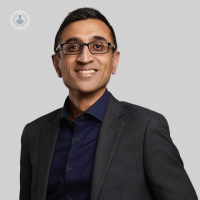What is foam sclerotherapy?
Sclerotherapy has been around as a treatment for a significant amount of time, and it involves injecting a special solution called a sclerosant into the vein, damaging the internal lining and creating a blood clot. The body then destroys the vein itself over time. With foam sclerotherapy, the solution is made into a foam by mixing it with a small amount of air and agitating the liquid. It is used as a treatment for varicose veins and thread veins.

How does foam sclerotherapy work?
In traditional sclerotherapy procedures, the blood can dilute the solution once it is injected into the vein. With a foam version of the solution, the air can in fact push the blood out of the way. The solution fills the vein, and stops when it comes into contact with larger veins, as it finally mixes with blood there and becomes ineffective.
Over a short amount of time, the air in the solution leaves the injected vein, but the blood which was pushed aside sticks to the vein’s lining. This then blocks the vein off, effectively destroying it.
How is foam sclerotherapy performed?
The surgeon applies local anaesthetic to the area they wish to treat. They use an ultrasound scan to detect the exact positioning of the vein, and insert a needle into it. The sclerosant solution is then injected, and the surgeon can monitor progress on the screen.
When enough foam has been injected, the needles are removed, and compression pads are applied to the leg.
What is the aftercare for foam sclerotherapy?
Bandages must be kept on for a few days. The patient then returns for a follow-up appointment, where the bandages and the compression pads will be removed.
Sometimes patients need more than one session to completely remove the varicose veins, but usually when treatment is completed, the varicose veins will no longer be visible. Sometimes bruising occurs, but this is mild and usually goes away after a period of weeks. This is typical for most treatments of varicose veins.
The patient can resume normal activity straight away, but is advised not to do vigorous exercise. This means patients can go back to work directly after the procedure, with little to no discomfort.
11-13-2012 08-29-2023Foam sclerotherapy
Mr David Greenstein - Vascular surgery
Created on: 11-13-2012
Updated on: 08-29-2023
Edited by: Conor Dunworth
What is foam sclerotherapy?
Sclerotherapy has been around as a treatment for a significant amount of time, and it involves injecting a special solution called a sclerosant into the vein, damaging the internal lining and creating a blood clot. The body then destroys the vein itself over time. With foam sclerotherapy, the solution is made into a foam by mixing it with a small amount of air and agitating the liquid. It is used as a treatment for varicose veins and thread veins.

How does foam sclerotherapy work?
In traditional sclerotherapy procedures, the blood can dilute the solution once it is injected into the vein. With a foam version of the solution, the air can in fact push the blood out of the way. The solution fills the vein, and stops when it comes into contact with larger veins, as it finally mixes with blood there and becomes ineffective.
Over a short amount of time, the air in the solution leaves the injected vein, but the blood which was pushed aside sticks to the vein’s lining. This then blocks the vein off, effectively destroying it.
How is foam sclerotherapy performed?
The surgeon applies local anaesthetic to the area they wish to treat. They use an ultrasound scan to detect the exact positioning of the vein, and insert a needle into it. The sclerosant solution is then injected, and the surgeon can monitor progress on the screen.
When enough foam has been injected, the needles are removed, and compression pads are applied to the leg.
What is the aftercare for foam sclerotherapy?
Bandages must be kept on for a few days. The patient then returns for a follow-up appointment, where the bandages and the compression pads will be removed.
Sometimes patients need more than one session to completely remove the varicose veins, but usually when treatment is completed, the varicose veins will no longer be visible. Sometimes bruising occurs, but this is mild and usually goes away after a period of weeks. This is typical for most treatments of varicose veins.
The patient can resume normal activity straight away, but is advised not to do vigorous exercise. This means patients can go back to work directly after the procedure, with little to no discomfort.


Foam sclerotherapy: how does it work?
By Mr David Greenstein
2024-11-21
Do you have veins that look unsightly on your legs, that sometimes bleed and leaves you aching? Fortunately, they can be treated with a procedure called foam sclerotherapy. We've talked to one of our leading vascular surgeons Mr David Greenstein about how it works and whether you can walk or take a flight soon after the procedure? See more


Hand vein treatment: is it possible to remove bulging veins in the hand?
By Mr Paul Baskerville
2024-11-20
Highly respected vascular surgeon, Mr Paul Baskerville explains how it is possible to remove bulging veins from your hand if you find them unsightly. See more
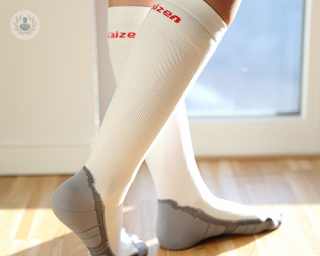

What to do with swollen veins: varicose vein treatment
By Ms Sophie Renton
2024-11-19
Varicose veins can be a real pain – these swollen and twisted blood vessels don’t work properly and can lead to a variety of problems. Leading vascular surgeon Ms Sophie Renton explains the options for treating varicose veins. See more


Varicose veins: When to see a specialist
By Mr Alastair Lewis
2024-11-19
Revered consultant vascular surgeon Mr Alastair Lewis shares his expert insight on varicose veins, including the causes, associated risk factors, and symptoms to be aware of. The leading specialist discusses the value of seeing a specialist about varicose vein concerns, in order to create a personally tailored management or treatment plan. See more
Experts in Foam sclerotherapy
-
Mr Sudip Ray
Vascular surgeryExpert in:
- Varicose veins
- Deep vein thrombosis (DVT)
- Minimally invasive artery surgery
- Peripheral arterial disease
- Varicose veins surgery
- Foam sclerotherapy
-
Professor Mark Whiteley
Vascular surgeryExpert in:
- Spider veins (thread veins)
- Phlebectomy
- Foam sclerotherapy
- Endovenous laser treatment (EVLA)
- Pelvic congestion syndrome
- Varicose veins surgery
-
Mr Muhammad Asad Rahi
Vascular surgeryExpert in:
- Varicose veins
- Radiofrequency ablation (RFA)
- Foam sclerotherapy
- Carotid artery disease
- Peripheral arterial disease
- Endovenous laser treatment (EVLA)
-
Mr Wissam Al-Jundi
Vascular surgeryExpert in:
- Aortic aneurysms
- Endovenous laser treatment (EVLA)
- Radiofrequency ablation (RFA)
- Spider veins (thread veins)
- Foam sclerotherapy
- Thoracic outlet syndrome (TOS)
-
Mr Sanjay Patel
Vascular surgeryExpert in:
- Varicose veins
- Varicose veins surgery
- Spider veins (thread veins)
- Endovenous laser treatment (EVLA)
- Foam sclerotherapy
- Leg ulcers
- See all

UK Vein Clinic
UK Vein Clinic
150 Harley St
No existe teléfono en el centro.
By using the telephone number provided by TOP DOCTORS, you automatically agree to let us use your phone number for statistical and commercial purposes. For further information, read our Privacy Policy
Top Doctors
-
UK Vein Clinic
150 Harley St, W1G Marylebone LondonExpert in:
- Radiofrequency ablation (RFA)
- Thread veins
- Endovenous laser treatment (EVLA)
- Foam sclerotherapy
- Varicose veins
- Most viewed diseases, medical tests, and treatments
- Hormone therapy
- Nutrition
- Weight loss injections
- Endermologie
- Polynucleotides
- Nipple discharge
- Abdominal pain
- Endovenous laser treatment (EVLA)
- Minimal access surgery (keyhole surgery)
- Head and neck cancer
